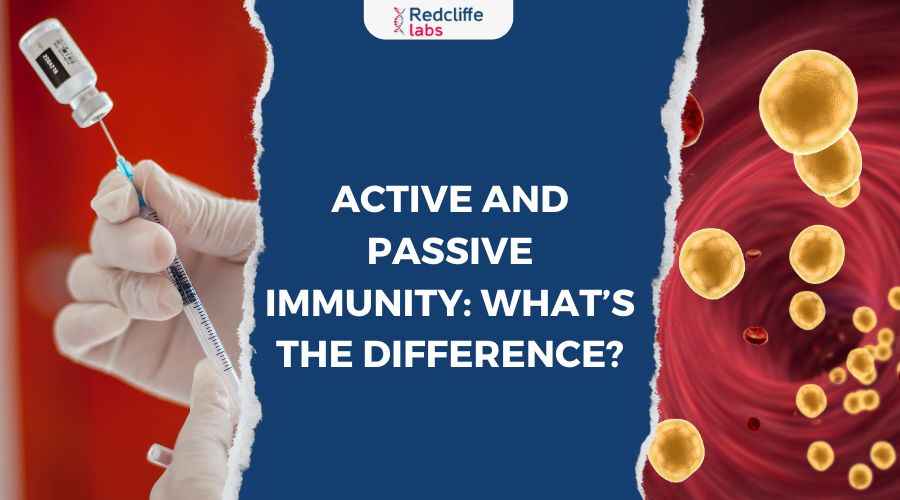Active and Passive Immunity: What’s the Difference?

Medically Reviewed By
Prof. Ashok Rattan
Written By Kirti Saxena
on Apr 1, 2025
Last Edit Made By Kirti Saxena
on Jul 19, 2025

Have you ever considered how your immunity works? If so, you might have known that immunity protects us from becoming sick in different ways.
Human bodies develop immunity against diseases in several ways. When the body comes in contact with any disease, like chicken pox and measles—typically as children—we usually develop natural, lifelong immunity against them after infection activates our immune systems.
In addition, immunity can be gained in several ways, such as vaccines, medications, breast milk, and catching a cold. How immunity is gained can be classified into active and passive immunity and further as artificial or naturally acquired. Both of these immunity acquires in different ways.
Active immunity develops when your own immune system protects you from pathogens, while passive immunity occurs when the body protects itself from pathogens through immunity gained from someone else.
In this article, we will explain both immunity types in detail.
Different Types of Immunity
Active Immunity
Active immunity occurs when the immune system produces antibodies in response to a pathogen or vaccine exposure. This type of immunity is long-lasting and can sometimes provide lifelong protection.
How Does Active Immunity Work?
When your body encounters a pathogen for the first time, the immune system recognizes it as a threat and triggers it. The body starts producing B and T cells, creating specific antibodies together. These antibodies remain in your body and provide protection against future infections from the same pathogen.
Types of Active Immunity
- Natural Active Immunity: As the name says, this immunity develops naturally in a person's body when exposed to any pathogen. For example, if a person gets infected with chickenpox, his immune system generates antibodies to fight the virus. Once recovered, the person gains long-term immunity against the virus.
- Artificial Active Immunity: This type of immunity is acquired through vaccination. Through vaccination, weak or inactive forms of pathogens are transferred, stimulating the immune system to produce antibodies without causing illness.
Also Read: Guarding Your Health: Exploring the Need for an Immunity Test
Passive Immunity
Passive immunity develops when antibodies are transferred from one person to another. It provides immediate but short-term protection.
How Does Passive Immunity Work?
In passive immunity, the body does not produce its antibodies. Instead, it receives ready-made antibodies from an external source. These antibodies help fight infections quickly but do not provide long-term immunity since they eventually degrade.
Types of Passive Immunity
- Natural Passive Immunity: This occurs when antibodies are naturally transferred from mother to baby through the placenta during pregnancy or breastfeeding after birth. This temporary immunity helps protect newborns from infections during the early months of life.
- Artificial Passive Immunity is acquired through medical treatments such as antibody injections, which are used to treat diseases like rabies and hepatitis.
Pros and Cons of Active Immunity
Pros:
- Active immunity is long-lasting or lifelong.
- This type of immunity develops memory cells to provide faster responses in future infections.
- Reduces the severity of infections.
Cons:
- Active immunity takes time to develop after exposure or vaccination.
- It may cause mild side effects such as fever or soreness at the injection site.
- Some diseases require multiple doses or booster shots for prolonged immunity.
Pros and Cons of Passive Immunity
Pros:
- Provides immediate protection against infections.
- Useful for people with weak immunity.
- It helps to protect newborns and infants who have immature immune systems.
- It is life-saving in emergency situations (e.g., rabies and hepatitis).
Cons:
- Short-term protection (weeks to months) since the body does not produce its own antibodies.
- This type of immunity does not produce memory cells, which means reinfection is possible.
- It may require repeated doses for continued protection.
- It can sometimes cause allergic reactions to injected antibodies.
Examples of Active and Passive Immunity
Examples of Active Immunity:
- Vaccinations- Measles, Mumps, Rubella (MMR) vaccine, COVID-19 vaccine, Flu vaccine.
- Natural Exposure- Recovering from chickenpox or COVID-19 and developing immunity.
- Hepatitis B Vaccine- Stimulates the immune system to produce antibodies for long-term protection.
Examples of Passive Immunity:
One of the most common examples of passive immunity is a mother and their child. The placenta and the breastmilk provide maternal antibodies to help keep them healthy.
- Placenta- In pregnant women, the nutrients and defense against illness work through placents and blood circulation. Women give their babies nutrition and defense against bacteria and illness. With blood and maternal antibodies, the baby is safe from bacteria and illness before birth and is susceptible to them after birth.
- Breastmilk- Breastmilk offers maternal antibodies. Specifically, the colostrum mothers produce immediately after birth helps pass along immunity.
The final Words
Active and passive immunity is crucial to protect the body against infections and diseases. While active active immunity provides long-term protection, passive immunity offers immediate but temporary protection.
However, vaccinations are the most effective way to develop immunity and prevent serious infections. However, passive immunity is important in emergency medical situations that require immediate protection. You can also take an immunity test from Redcliffe Labs to know how strong you are. A strong immunity means a strong you. So, to achieve a stronger immunity, live a healthy lifestyle and get vaccinated in a timely manner.
Read more: Top 10 Immunity Booster Foods to Fight Against Infections
FAQ's
1. What is the difference between active and passive immunity?
Active immunity means when your body's own immune system produces antibodies when it comes in contact with a pathogen or vaccine, while passive immunity develops when receiving pre-made antibodies from an external source, like a mother to her child, offering immediate but temporary protection.
2. What is an example of passive immunity?
An example of passive immunity is a newborn baby acquiring antibodies from its mother through the placenta or breast milk.
3. Is breastfeeding passive immunity?
Breastfeeding provides passive and likely long-lasting active immunity.



